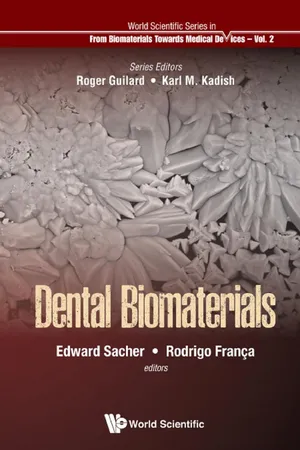
- 492 pages
- English
- ePUB (mobile friendly)
- Available on iOS & Android
Dental Biomaterials
About this book
The contents of this book touch on the all major dental biomaterials: polymers, composites, ceramics and metals. The first part introduces the readers to the surface physicochemical and mechanical characterizations at the nanoscopic level, and the use of finite element analysis. The second part discusses dental adhesion, resin-based composites, polymerization contraction stress, impression materials and soft liners for total prosthesis. The third part deals with ceramics in restorative dentistry: zirconia and lithium disilicate, the fractography of dental ceramics, as well as bioglass for bone growth. The fourth part discusses the toxicity of mercury in dentistry, and the use of preventive materials for dental diseases. The concluding part identifies imminent techniques for dental biomaterials, such as additive manufacturing (3D printing), and bioprinting in dentistry.
Contents:
- Surface Analysis Techniques for Dental Materials (Edward Sacher and Rodrigo França)
- Nanoindentation Techniques in Dental Biomaterials (Mohammad Aramfard and Chuang Deng)
- Finite Element Analysis in Dentistry (Josete B C Meira, Alice N Jikihara, Pavel Capetillo, Marina G Roscoe, Paolo M Cattaneo, and Rafael Y Ballester)
- Preventive Dental Materials (Larissa Bubnowicz and Rodrigo França)
- Mercury Toxicity (Gelson Luis Adabo)
- Zirconia in Dentistry (Paulo Francisco Cesar, Susana Salazar-Marocho, Erick de Lima, Lucas Hian da Silva, Karen Fukushima, and Ranulfo Benedito de Paula Miranda)
- Lithium Disilicate-Based Glass-Ceramics (Rodrigo França)
- Fractography of Dental Ceramics (Susanne S Scherrer)
- Bioactive Glasses for the Development of Dental Restorative Materials (José Bauer, Ceci Nunes Carvalho, Edilausson Moreno Carvalho, and Rodrigo França)
- Dental Adhesives (Marcelo Giannini, Patrícia Makishi, Ronaldo Hirata, and Carolina Bosso André)
- Dental Composites — Chemistry and Composition (Carmem S Pfeifer)
- Development of Polymerization Contraction Stresses in Resin-Based Composites (Roberto Ruggiero Braga, Marcela Charantola Rodrigues, and Yvette Alania)
- Flexible Impression Materials (Charlene S Solomon)
- Resilient Liners for Removable Prosthesis (Igor J Pesun)
- 3D Printing — Additive Manufacturing of Dental Biomaterials (Rodrigo França, Jeff Winkler, Helen H Hsu, Maedeh Rahimnejad, and Zahra Abdali)
Readership: The book will be of great value to pathologists, oncologists and oncologic surgeons, residents in these specialties, and all related professionals who need to learn the nuts and bolts of this new translational medicine.Dental Biomaterials;Polymers;Ceramics;Resin-Based Composites;Nanoscopic Materials;Restorative Dentistry;Titanium Alloy;Dental Implants;Additive Manufacturing00
Frequently asked questions
- Essential is ideal for learners and professionals who enjoy exploring a wide range of subjects. Access the Essential Library with 800,000+ trusted titles and best-sellers across business, personal growth, and the humanities. Includes unlimited reading time and Standard Read Aloud voice.
- Complete: Perfect for advanced learners and researchers needing full, unrestricted access. Unlock 1.4M+ books across hundreds of subjects, including academic and specialized titles. The Complete Plan also includes advanced features like Premium Read Aloud and Research Assistant.
Please note we cannot support devices running on iOS 13 and Android 7 or earlier. Learn more about using the app.
Information
Chapter 1
Surface Analysis Techniques for Dental Materials
Département de Génie Physique, École Polytechnique de Montréal,
C.P. 6079, Montréal, Québec H3C 3A7, Canada
†Department of Restorative Dentistry, Dental Biomaterials
Research Laboratory, College of Dentistry, University
of Manitoba, 780 Bannatyne Av, Winnipeg,
Manitoba R3E 0W2, Canada
1.Introduction
1.1.Surface and Interfaces

1.2.Surface Energy
1.3.Forces at Interfaces
1.4.Reactions at Surfaces: Adsorption
Table of contents
- Cover
- Halftitle
- Series Editors
- Title
- Copyright
- Preface
- About the Editors
- Contents
- Chapter 1 Surface Analysis Techniques for Dental Materials
- Chapter 2 Nanoindentation Techniques in Dental Biomaterials
- Chapter 3 Finite Element Analysis in Dentistry
- Chapter 4 Preventive Dental Material
- Chapter 5 Mercury Toxicity
- Chapter 6 Zirconia in Dentistry
- Chapter 7 Lithium Disilicate-Based Glass-Ceramics
- Chapter 8 Fractography of Dental Ceramics
- Chapter 9 Bioactive Glasses for the Development of Dental Restorative Materials José Bauer, Ceci Nunes Carvalho,
- Chapter 10 Dental Adhesives
- Chapter 11 Dental Composites — Chemistry and Composition
- Chapter 12 Development of Polymerization Contraction Stresses in Resin-Based Composites
- Chapter 13 Flexible Impression Materials
- Chapter 14 Resilient Liners for Removable Prosthesis
- Chapter 15 3D Printing — Additive Manufacturing of Dental Biomaterials
- Index